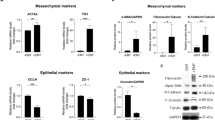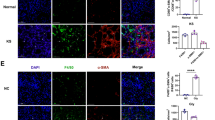Summary
The roles of mitogen-activated protein kinase (MAPK) signal pathway in sodium salicylate-induced expression of heat shock protein 27 (HSP27) in human lens epithelial cells (HLECs-B3) in vitro were investigated. HLECs-B3 were incubated in the fresh media containing sodium salicylate at different concentrations for different durations, and allowed to be recovered in fresh medium without sodium salicylate for different durations with or without pretreatment with p38MAPK inhibitor (SB203580), ERK1/2 inhibitor (PD98059) and JNK/SAPK inhibitor (SP600125). The expression of P38MAPK, ERK1/2, JNK/SAPK, phosphorylated P38MAPK, phosphorylated ERK1/2, phosphorylated JNK/SAPK and HSP27 was detected by Western blot. The expression of HSP27 mRNA and protein was detected by RT-PCR and immunohistochemistry respectively. It was found there was only weak expression of HSP27 in normal HLECs. The expression of HSP27 was not detectable in HLECs-B3 that were exposed to sodium salicylate (55 mmol/L) for 1–5 h. It was indicated that recovery from sodium salicylate (>35 mmol/L) significantly increased the synthesis of HSP27. The expression of HSP27 was up-regulated in HLECs-B3 under sodium salicylate recovery for 3 h, reached the peak level for 6 h, and returned to the level of control cells by 24 h. Activation of P38MAPK from sodium salicylate stimulation occurred at 30th min, and increased significantly at 1st h, then declined and returned to baseline level at 3rd h under sodium salicylate recovery. Activation of ERK1/2 occurred at 1st h and reached the peak level at 6th h under sodium salicylate recovery. However, JNK/SAPK was inactivated by sodium salicylate. The expression of HSP27 could be down-regulated with the pretreatment of SB203580 and PD98059 jointly. It is concluded that sodium salicylate can induce the expression of HSP27 in HLECs-B3. The effects are mediated, at least in part, through the activation of P38MAPK and ERK1/2 signaling pathway.
Similar content being viewed by others
References
Horwitz J. Alpha-crystallin can function as a molecular chaperone. Proc Natl Acad Sci USA, 1992,89:10 449–10 453
Wang Z, Zhou Y. Effects of sodium salicylate on the expression of HSP27 protein during oxidative stress in tissue-cultured human lens epithelial cells. J Huazhong Univ Sci Technol Med Sci, 2006,26(6):753–755
Bu L, Jin YP, Shi YF, et al. Mutant DNA-binding domain of HSF 4 is associated with autosomal dominant lamellar and Marner cataract. Nat Genet, 2002,31(7):1–3
Morimoto RI. Regulation of the heat shock transcriptional response: cross talk between a family of heat shock factors, molecular chaperones, and negative regulators. Genes Dev, 1998, 15,12(24):3788–3796
Pirkkala L, Nykänen P, Sistonen L. Roles of the heat shock transcription factors in regulation of the heat shock response and beyond. FASEB J, 2001,15(7):1118–1131
Manalo DJ, Liu AY. Resolution, detection, and characterization of redox conformers of human HSF1. J Biol Chem, 2001,276(26):23 554–23 561
Manalo DJ, Lin Z, Liu AY. Redox-dependent regulation of the conformation and function of human heat shock factor 1. Biochemistry, 2002,41(8):2580–2588
Jurivich DA, Pachetti C, Qiu L, et al. Salicylate triggers heat shock factor differently than heat. J Biol Chem, 1995,270(41):24 489–24 495
Housby JN, Cahill CM, Chu B, et al. Non-steroidal anti-inflammatory drugs inhibit the expression of cytokines and induce HSP70 in human monocytes. Cytokine, 1999,11(5):347–358
Liu RY, Corry PM, Lee YJ, et al. Potential involvement of a constitutive heat shock element binding factor in the regulation of chemical stress-induced hsp70 gene expression. Mol Cell Biochem, 1995,144(1):27–34
Ishihara K, Horiguchi K, Yamagishi N, et al. Identification of sodium salicylate as an hsp inducer using a simple screening system for stress response modulators in mammalian cells. Eur J Biochem, 2003,270(16):3461–3468
Temussi PA, Masino L, Pastore A. From Alzheimer to Huntington: why is a structural understanding so difficult? EMBO J, 2003,22(3):355–361
Bonini N M. Chaperoning brain degeneration. Proc Natl Acad Sci USA, 2002,99(Suppl 4):16 407–16 411
in t’ Veld BA, Ruitenberg A, Hofman A, et al. Nonsteroidal antiinflammatory drugs and the risk of Alzheimer’s disease. N Engl J Med, 2001,345(21):1515–1521
Weggen S, Eriksen JL, Das P, et al. A subset of NSAIDs lower amyloidogenic Abeta42 independently of cyclooxygenase activity. Nature, 2001,414(6860):212–216
Dhanasekaran N, Premkumar Reddy E. Signaling by dual specificity kinases. Oncogene, 1998,17(11 Reviews): 1447–1455
Ono K, Han J. The p38 signal transduction pathway: activation and function. Cell Signal, 2000, 12(1):1–13
Seger R, Krebs EG. The MAPK signaling cascade. FASEB J, 1995,9(9):726–735
Lee EJ, Park HG, Kang HS. Sodium salicylate induces apoptosis in HCT116 colorectal cancer cells through activation of p38MAPK. Int J Oncol, 2003,23(2):503–508
Kim CH, Kim MY, Moon JY. Implication of NAG-1 in synergistic induction of apoptosis by combined treatment of sodium salicylate and PI3K/MEK1/2 inhibitors in A549 human lung adenocarcinoma cells. Biochem Pharmacol, 2008,75(9):1751–1760
Author information
Authors and Affiliations
Rights and permissions
About this article
Cite this article
Wang, Z., Gao, R., Huang, Y. et al. Effects of mitogen-activated protein kinase signal pathway on heat shock protein 27 expression in human lens epithelial cells exposed to sodium salicylate in vitro . J. Huazhong Univ. Sci. Technol. [Med. Sci.] 29, 377–382 (2009). https://doi.org/10.1007/s11596-009-0323-x
Received:
Published:
Issue Date:
DOI: https://doi.org/10.1007/s11596-009-0323-x




